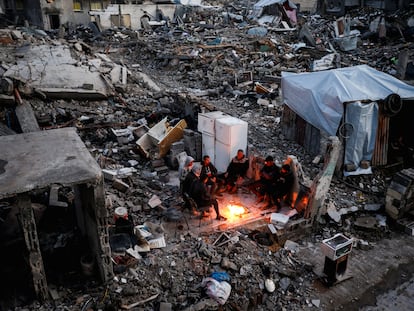Netanyahu drags his feet on Gaza ceasefire
Strategic superiority and US backing allow Israel to ignore the terms of the agreement while demanding strict compliance from Hamas, just as it does with Hezbollah in Lebanon
A gala dinner at a conference of presidents of major Jewish-American organizations in Jerusalem. Israeli Prime Minister Benjamin Netanyahu takes the floor. He is already accustomed to adopting a messianic tone, but this Sunday he is cocky, aware that he is playing at home and that, as he emphasizes, “Israel has never been so strong, nor has the alliance with the United States.” The audience starts to applaud but stops, not wishing to interrupt the speech. Netanyahu pauses and says: “You can applaud.”
This is Netanyahu’s mood regarding the Gaza truce, which has been in place for almost a month with Donald Trump now in the White House. The second of the three phases of the ceasefire is due to begin in early March. The agreement stipulates that negotiations on the transition from phase one to phase two should have started almost two weeks ago.
Hamas sent a delegation to Doha and Cairo. Netanyahu did so only on February 17, after meeting with the U.S. envoy for the Middle East, Steve Witkoff, a more sober man with a less changeable mood than Trump, who has gone from ending an interview in 2021 regarding Netanyahu with the phrase “Fuck him,” to showering the Israeli prime minister with political gifts since his return to power in January. “Instead of helping Netanyahu find his footing on the solid ground of reality, Trump is pushing him to the edge of the abyss,” wrote Nahum Barnea, one of Israel’s leading political commentators, in the Yediot Aharonot newspaper on Monday.
Netanyahu did not send a negotiating delegation earlier precisely because he was travelling to the U.S. and wanted to know what really matters: what Trump would say to him. He came out with a big smile and a plan to “transfer” Gaza’s 2.3 million inhabitants and leave it under U.S. control. He was away for a week (the opposition was irritated that he was following an exchange of Israeli hostages for Palestinian prisoners on Saturday remotely) and it took him three days to convene his security cabinet, while the mediators waited for a signal.
On Sunday, he met with Witkoff, who in a television interview said that there would “certainly” be a second phase of the ceasefire, despite it being “more complicated and intricate.” Netanyahu sent his team to Cairo on Monday to discuss only the first phase. He later changed a statement to clarify that the security cabinet would give him “instructions for the continuation of negotiations on the second phase.”
The cabinet meeting was a condition for the ultra-right Finance Minister Bezalel Smotrich to remain in the government, despite his opposition to the ceasefire. Smotrich says that Netanyahu had promised him from the outset that he will resume the war, and that he will overthrow the government if he breaks his word. He also claims that he has “begun preparations” with the Trump team to launch the plan for the ethnic cleansing of Gaza, which he hopes to see begin “in the coming weeks.” “Gazans will have nothing to look for in Gaza in the next 10-15 years. After we return to fighting and all of Gaza looks like Jabalia [a city of 200,000 inhabitants reduced to ruins by the bombings] — they will have nothing to look for there at all,” he said last week in an interview.
The ceasefire agreement sets the duration — six weeks — and the objective of the second phase: the end of the war and the handover of the remaining Israeli hostages, who would then number around 60, both alive and dead. But not the path, since closing the details a priori would have made the agreement impossible.
That is, according to Mairav Zonszein, senior analyst on Israel at the International Crisis Group think tank, precisely the “big question”: “What form will this second phase take? We already know that Netanyahu is trying to drag things out. And that the rhetoric of Trump’s Gaza plan is definitely a gift to Netanyahu’s coalition, because you can’t be more extreme right than the ethnic cleansing of Gaza,” she said in a telephone conversation. But, on the other hand, “he now has a more stable government to move forward with the release of hostages” and it would be “very difficult” for him to appear before the whole of Israel as responsible for the derailment of the agreement, which would entail mobilizing troops again and “more deaths of soldiers and hostages,” without “very quickly obtaining a narrative of victory.”
The leaks suggest that Israel will basically ask Hamas for something like a surrender: to first give up its only bargaining chip (the hostages) and then to give up power (including its role in monitoring the transport of humanitarian aid), and eventually to disarm. The fundamentalist party-militia is prepared to do the former — as long as it remains in the hands of the Palestinian Authority (PA), which Netanyahu reiterated on Monday will have no role in post-war Gaza — and the latter, but within the framework of the creation of a Palestinian state, which the Israeli prime minister opposes.
Meanwhile, Trump and Netanyahu propose emptying Gaza and turning it into the “Middle Eastern Riviera,” repopulated by “people from around the world.” “Everything Israel and the United States have been saying gives Hamas no incentive to move forward with the release of hostages, but I don’t think Trump is really interested in taking control of Gaza,” Zonszein says. The big dilemma, which hits at the heart of the second phase, is, the analyst believes, how they intend to achieve their goal of removing Hamas from power. “While it doesn’t necessarily have an interest in governing Gaza, it is an armed resistance group. And I don’t think it will agree to disarm or be completely vulnerable. Israel doesn’t have many good options in this regard.”
Israel has so far failed to comply with the first phase of the ceasefire. It should have allowed the entry of 60,000 trailers (as temporary housing for those who have lost their homes) and heavy machinery to clear the rubble. This has not happened. Hamas claimed to have received guarantees last week from the mediators, in exchange for backing down on its threat not to hand over hostages last Saturday. One of the ministers in the security cabinet, Zeev Elkin, on Monday defended the use of “any tool of pressure” to get the hostages back.
“The gates of hell”
Israel is expecting the bodies of four hostages to be released on Thursday and is trying to get Hamas to release six hostages who are still alive and were due to be exchanged in the first phase on Saturday, instead of over two weeks as stipulated in the agreement. Only four of the 33 deceased hostages from the first phase would then remain. The agreement stipulates the order of the exchanges, but the mood has changed since Trump threatened Hamas that “the gates of hell” would open in Gaza if it did not release the remaining 76 on Saturday, although in the end neither happened.
On the other hand, Israeli bombings are occasional, but they constitute a violation of the pact and have already caused nearly 100 deaths from direct attacks, according to the Gazan Ministry of Health. The latest occurred on Sunday when three Hamas policemen who were monitoring the distribution of humanitarian aid in Rafah were killed, according to the Ministry of the Interior. The Israeli army claims that “they were heading towards the troops” and the Minister of Defense, Israel Katz, stressed that anyone who enters the buffer zone where there is a military presence will bear responsibility for their own death.
Only one rocket has been fired from inside Gaza in February, in a confusing episode for which no militia has claimed responsibility. It fell inside the Strip, killing a teenager, and Smotrich reacted by calling for “a serious and disproportionate response.”
What is unfolding is a kind of “Lebanese-style truce.” That is, a ceasefire that applies strictly to one party (whether Hezbollah or Hamas), but which Israel violates on a daily basis. Firstly, because it can (it is, especially now, the stronger party in the equation) and because, both in Gaza and in Lebanon, the line of non-compliance is essentially marked by its biggest ally, the United States. In Lebanon, Washington first blessed the failure to respect the deadline for the withdrawal of troops from the south of the country and on Monday, it did so again by allowing Israeli forces to remain in five strategic military points, despite the agreement. Lebanese President Joseph Aoun has admitted his government’s inability to resort to anything more than diplomatic protests.
Sign up for our weekly newsletter to get more English-language news coverage from EL PAÍS USA Edition
Tu suscripción se está usando en otro dispositivo
¿Quieres añadir otro usuario a tu suscripción?
Si continúas leyendo en este dispositivo, no se podrá leer en el otro.
FlechaTu suscripción se está usando en otro dispositivo y solo puedes acceder a EL PAÍS desde un dispositivo a la vez.
Si quieres compartir tu cuenta, cambia tu suscripción a la modalidad Premium, así podrás añadir otro usuario. Cada uno accederá con su propia cuenta de email, lo que os permitirá personalizar vuestra experiencia en EL PAÍS.
¿Tienes una suscripción de empresa? Accede aquí para contratar más cuentas.
En el caso de no saber quién está usando tu cuenta, te recomendamos cambiar tu contraseña aquí.
Si decides continuar compartiendo tu cuenta, este mensaje se mostrará en tu dispositivo y en el de la otra persona que está usando tu cuenta de forma indefinida, afectando a tu experiencia de lectura. Puedes consultar aquí los términos y condiciones de la suscripción digital.










































